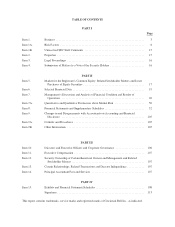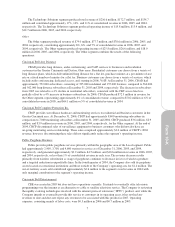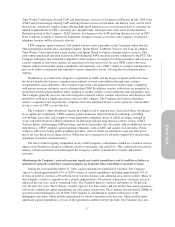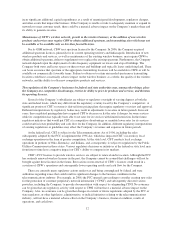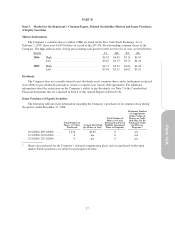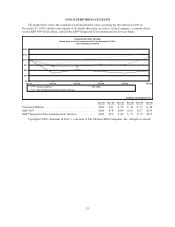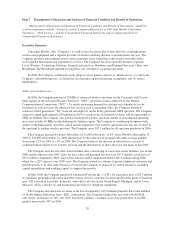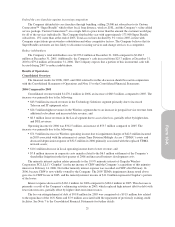Cincinnati Bell 2006 Annual Report Download - page 121
Download and view the complete annual report
Please find page 121 of the 2006 Cincinnati Bell annual report below. You can navigate through the pages in the report by either clicking on the pages listed below, or by using the keyword search tool below to find specific information within the annual report.
Time Warner Cable began offering VoIP and long distance services in Cincinnati and Dayton. In July 2004, both
AT&T and Verizon began offering VoIP and long distance service in Cincinnati and Dayton. Also, in July 2004,
the local gas and electric supplier began offering high-speed Internet access over electrical lines to customers in
limited neighborhoods of CBT’s operating area. Insight Cable, which provides cable service in the northern
Kentucky portion of the Company’s ILEC territory, has begun to offer VoIP and long distance services in 2007.
If the Company is unable to effectively implement strategies to retain access lines, the Company’s traditional
telephone business will be adversely affected.
CBW competes against national, well-funded wireless service providers in the Cincinnati and/or Dayton,
Ohio metropolitan market areas, including Cingular, Sprint Nextel, T-Mobile, Verizon, and Leap. In addition,
Time Warner Cable entered into a joint venture with Sprint Nextel to explore offering wireless services. This
joint venture purchased spectrum licenses in 2006 during the AWS spectrum auction conducted by the FCC. The
Company anticipates that continued competition could compress its margins for wireless products and services as
carriers continue to offer more minutes for equivalent or lower service fees because CBW cannot offer more
minutes without incremental capital expenditures and operating costs. CBW’s ability to compete will depend, in
part, on its ability to anticipate and respond to various competitive factors affecting the telecommunications
industry.
Furthermore, as evidenced by Cingular’s acquisition of AWE, and the merger of Sprint and Nextel, there
has been a trend in the wireless communications industry towards consolidation through joint ventures,
reorganizations, and acquisitions. The Company expects this consolidation trend to lead to larger competitors
with greater resources and more service offerings than CBW. In addition, wireless subscribers are permitted to
retain their wireless phone numbers when changing to another wireless carrier within the same geographic area.
The Company generally does not enter into long-term contracts with its wireless subscribers, and, therefore, this
portability could have a significant adverse affect on the Company. The Company also believes that these
wireless competitors and, in particular, companies that offer unlimited wireless service plans for a flat monthly
fee are a cause of CBT’s access line loss.
The Company’s other subsidiaries operate in a largely local or regional area, and each of these subsidiaries
faces significant competition. CBTS competes against numerous other information technology consulting,
web-hosting, data center and computer system integration companies, many of which are larger, national in
scope, and better financed. CBAD competitors include large national long-distance carriers, such as AT&T,
Verizon, Sprint, and emerging VoIP providers, and wireless providers that offer plans with no additional fees for
long distance. CBCP competes against national companies, such as ADT, and against local providers. Public
competes with several other public payphone providers, some of which are national in scope and offer lower
prices for coin-based local calling services. Public has also continued to be adversely impacted by the growing
popularity of wireless communications.
The effect of the foregoing competition on any of the Company’s subsidiaries could have a material adverse
impact on its businesses, financial condition, results of operations, and cash flows. This could result in increased
reliance on borrowed funds and could impact the Company’s ability to maintain its wireline and wireless
networks.
Maintaining the Company’s networks requires significant capital expenditures and its inability or failure to
maintain its networks would have a material impact on its market share and ability to generate revenue.
During the year ended December 31, 2006, capital expenditures totaled $151.3 million. The Company
expects to spend approximately 19% of 2007 revenue on capital expenditures including approximately 8% of
revenue in order to construct a 3G network for its wireless business and additional data center facilities. Many of
the Company’s wireless competitors have already implemented a 3G network, which allow customers access to
enhanced data services, such as streaming video. The Company plans to construct and deploy its 3G network
over the next two years. The Company currently operates five data centers and any further data center expansion
will involve significant capital expenditures for data center construction. The Company also purchased 10MHz of
spectrum in the Indianapolis area in 2006. The Company is considering its options with respect to the
Indianapolis spectrum, which include expansion of its wireless operations into this area, which would require
significant capital expenditures, or lease of the spectrum to another wireless provider. The Company may also
11



